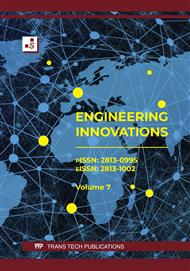[1]
Kheirandish S., Saghafian H., Hedjazi J., et al. Effect of heat treatment on microstructure of modified cast AISI D3 cold work tool steel. Journal of Iron & Steel Research International 2010; 17: 40-45,52.
DOI: 10.1016/s1006-706x(10)60140-9
Google Scholar
[2]
Lin N., Xie F. and Zou J. Application of artificial neural network in predicting the thickness of chromizing coatings on P110 steel. Journal of Wuhan University of Technology-Mater Sci Ed 2013; 28: 196-201.
DOI: 10.1007/s11595-013-0664-y
Google Scholar
[3]
Momeni M., Kheirandish S., Saghafian H., et al. Effects of heat treatment on mechanical properties of modified cast AISI D3 tool steel. Materials & Design 2014; 54: 742-747.
DOI: 10.1016/j.matdes.2013.09.002
Google Scholar
[4]
Yang X. and Liu C. Machining titanium and its alloys. Machining Science & Technology 1999; 3: 107-139.
DOI: 10.1080/10940349908945686
Google Scholar
[5]
Li Y., Tian W., Lei L., et al. Research progress of processing technique of difficult-to-machine aviation material. Equipment Manufacturing Technology 2018: 12-17.
Google Scholar
[6]
Sahoo P., Patra K., Singh V. K., et al. Influences of TiAlN coating and limiting angles of flutes on prediction of cutting forces and dynamic stability in micro milling of die steel (P-20). Journal of Materials Processing Technology 2020; 278: 116500.
DOI: 10.1016/j.jmatprotec.2019.116500
Google Scholar
[7]
Kumar P., Chauhan S. R., Pruncu C. I., et al. Influence of different grades of CBN inserts on cutting force and surface roughness of AISI H13 die tool steel during hard turning operation. Materials 2019; 12: 177-196.
DOI: 10.3390/ma12010177
Google Scholar
[8]
Jasni N., Lajis M. A. and Kamdani K. Tool wear performance of TiAlN/AlCrN multilayer coated carbide tool in machining of AISI D2 hardened steel. Advanced Materials Research 2012; 488- 489: 462-467.
DOI: 10.4028/www.scientific.net/amr.488-489.462
Google Scholar
[9]
Amal M. The effect of cutting parameter on surface roughness during end milling of AISI D2 tool steel. Universiti Teknikal Malaysia Melaka, Malaysia, 2014.
DOI: 10.1299/jsmedsd.2014.24._2308-1_
Google Scholar
[10]
Yavuz K., Riza M. A., Muammer N., et al. The effects of process parameters on acceleration amplitude in the drilling of cold work tool steels. International Journal of Advanced Manufacturing Technology 2015; 80: 1387-1401.
DOI: 10.1007/s00170-015-7097-z
Google Scholar
[11]
Shah U. and Liu X. Effects of ultrasonic vibration on resistance spot welding of transformation induced plasticity steel 780 to aluminum alloy AA6061. Materials & design 2019; 182: 108053.[12] Kiswanto G., Johan Y. R., Poly P., et al. Machined surface roughness geometry model development on ultrasonic vibration assisted micromilling with end mill. Key Engineering Materials 2020; 846: 122-127.
DOI: 10.4028/www.scientific.net/kem.846.122
Google Scholar
[13]
Xu W. and Zhang L. Ultrasonic vibration-assisted machining: principle, design and application. Advances in Manufacturing 2015; 3: 173-192.
DOI: 10.1007/s40436-015-0115-4
Google Scholar
[14]
Nam T. H., Son T. A., Hai N. T., et al. Design of 2D wave booster ultrasonic vibration-assisted cutting tool in small size surface machining. Key Engineering Materials 2022; 923: 75-83.
DOI: 10.4028/p-ta844x
Google Scholar
[15]
Li Z., Yu D. and Sun T. Research status of the vibration assisted machining (VAM) technology. Machine Tool & Hydraulics 2015; 43: 1-16.
Google Scholar
[16]
Dhupal D., Doloi B. and Bhattacharyya B. Pulsed Nd: YAG laser turning of micro-groove on aluminum oxide ceramic (Al2O3). International Journal of Machine Tools & Manufacture 2008; 48: 236-248.
DOI: 10.1016/j.ijmachtools.2007.08.016
Google Scholar
[17]
Chen G., Zou Y., Qin X., et al. Geometrical texture and surface integrity in helical milling and ultrasonic vibration helical milling of Ti-6Al-4V alloy. Journal of Materials Processing Technology 2020; 278: 116494.
DOI: 10.1016/j.jmatprotec.2019.116494
Google Scholar
[18]
Zhang M., Zhang D., Geng D., et al. Effects of tool vibration on surface integrity in rotary ultrasonic elliptical end milling of Ti-6Al-4V. Journal of Alloys and Compounds 2020; 821: 153266.
DOI: 10.1016/j.jallcom.2019.153266
Google Scholar
[19]
Hampa P. S., Razfar M. R., Malaki M., et al. The role of dry aero-acoustical lubrication and material softening in ultrasonically assisted milling of difficult-to-cut AISI 304 steels. Transactions of the Indian Institute of Metals 2014; 68: 43-49.
DOI: 10.1007/s12666-014-0429-0
Google Scholar
[20]
Suarez A., Veiga F., Lacalle L., et al. Effects of ultrasonics-assisted face milling on surface integrity and fatigue life of Ni-Alloy 718. Journal of Materials Engineering and Performance 2016; 25: 5076-5086.
DOI: 10.1007/s11665-016-2343-6
Google Scholar
[21]
Kurniawan R., Kumaran S. T., Ali S., et al. Experimental and analytical study of ultrasonic elliptical vibration cutting on AISI 1045 for sustainable machining of round-shaped microgroove pattern. The International Journal of Advanced Manufacturing Technology 2018; 98: 2031-2055.
DOI: 10.1007/s00170-018-2359-1
Google Scholar
[22]
Zhang X., Sui H., Zhang D., et al. Feasibility study of high-speed ultrasonic vibration cutting titanium alloy. Journal of Materials Processing Technology 2017; 247: 111-120.
DOI: 10.1016/j.jmatprotec.2017.03.017
Google Scholar
[23]
Tao G., Chao M., Shen X., et al. Experimental and modeling study on cutting forces of feed direction ultrasonic vibration-assisted milling. International Journal of Advanced Manufacturing Technology 2017; 90: 709-715.
DOI: 10.1007/s00170-016-9421-7
Google Scholar
[24]
Feng Y.,Hsu F.,Lu Y., et al. Force prediction in ultrasonic vibration-assisted milling. Machining Science and Technology 2020: 1-24.
Google Scholar
[25]
Feng Y.,Hsu F.,Lu Y., et al. Surface roughness prediction in ultrasonic vibration-assisted milling. Journal of Advanced Mechanical Design Systems and Manufacturing 2020; 14(4):1-14.
DOI: 10.1299/jamdsm.2020jamdsm0063
Google Scholar
[26]
Dong Z., Wei Q., Liu J., et al. Experimental research on cutting characteristics of SiCp/Al axial ultrasonic vibration micro milling. Manufacturing Technology & Machine Tool 2020: 34-37.
Google Scholar
[27]
Wang X., Zhu X., Gao J., et al. Milling research and tool selection design of SiC14Cu4Mg0.5Si based on aluminium matrix 2A14. Journal of Wuhan University of Technology-Mater Sci Ed 2016; 31: 1377-1380.[28] Li Z., Guo H., Li L., et al. Study on surface quality and tool life in ultrasonic vibration countersinking of titanium alloys (Ti6Al4V). The International Journal of Advanced Manufacturing Technology 2019; 103: 1119-1137.
DOI: 10.1007/s11595-016-1541-2
Google Scholar
[29]
Kurniawan R. and Ko T. J. Surface topography analysis in three-dimensional elliptical vibration texturing (3D-EVT). International Journal of Advanced Manufacturing Technology 2019; 102: 1601-1621.
DOI: 10.1007/s00170-018-03253-1
Google Scholar


